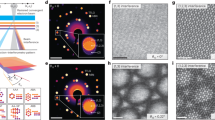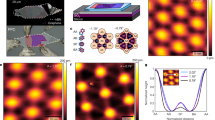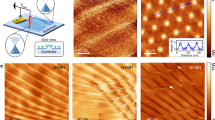Abstract
Dislocations represent one of the most fascinating and fundamental concepts in materials science1,2,3. Most importantly, dislocations are the main carriers of plastic deformation in crystalline materials4,5,6. Furthermore, they can strongly affect the local electronic and optical properties of semiconductors and ionic crystals7,8. In materials with small dimensions, they experience extensive image forces, which attract them to the surface to release strain energy9. However, in layered crystals such as graphite, dislocation movement is mainly restricted to the basal plane. Thus, the dislocations cannot escape, enabling their confinement in crystals as thin as only two monolayers. To explore the nature of dislocations under such extreme boundary conditions, the material of choice is bilayer graphene, the thinnest possible quasi-two-dimensional crystal in which such linear defects can be confined. Homogeneous and robust graphene membranes derived from high-quality epitaxial graphene on silicon carbide10 provide an ideal platform for their investigation. Here we report the direct observation of basal-plane dislocations in freestanding bilayer graphene using transmission electron microscopy and their detailed investigation by diffraction contrast analysis and atomistic simulations. Our investigation reveals two striking size effects. First, the absence of stacking-fault energy, a unique property of bilayer graphene, leads to a characteristic dislocation pattern that corresponds to an alternating AB  AC change of the stacking order. Second, our experiments in combination with atomistic simulations reveal a pronounced buckling of the bilayer graphene membrane that results directly from accommodation of strain. In fact, the buckling changes the strain state of the bilayer graphene and is of key importance for its electronic properties11,12,13,14. Our findings will contribute to the understanding of dislocations and of their role in the structural, mechanical and electronic properties of bilayer and few-layer graphene.
AC change of the stacking order. Second, our experiments in combination with atomistic simulations reveal a pronounced buckling of the bilayer graphene membrane that results directly from accommodation of strain. In fact, the buckling changes the strain state of the bilayer graphene and is of key importance for its electronic properties11,12,13,14. Our findings will contribute to the understanding of dislocations and of their role in the structural, mechanical and electronic properties of bilayer and few-layer graphene.
This is a preview of subscription content, access via your institution
Access options
Subscribe to this journal
Receive 51 print issues and online access
$199.00 per year
only $3.90 per issue
Buy this article
- Purchase on Springer Link
- Instant access to full article PDF
Prices may be subject to local taxes which are calculated during checkout




Similar content being viewed by others
References
Mott, N. F. Dislocations and the theory of solids. Nature 171, 234–237 (1953)
Orowan, E. Zur Kristallplastizität. III. Über den Mechanismus des Gleitvorganges. Z. Phys. 89, 634–659 (1934)
Taylor, G. I. The mechanism of plastic deformation of crystals. Part II. Comparison with observations. Proc. R. Soc. A 145, 388–404 (1934)
Cottrell, A. H. & Bilby, B. A. Dislocation theory of yielding and strain ageing of iron. Proc. Phys. Soc. A 62, 49–62 (1949)
Frank, F. & Read, W. Multiplication processes for slow moving dislocations. Phys. Rev. 79, 722–723 (1950)
Nabarro, F. R. N. Mathematical theory of stationary dislocations. Adv. Phys. 1, 269–394 (1952)
Shockley, W. Dislocations and edge states in the diamond crystal structure. Phys. Rev. 91, 228 (1953)
Smoluchowski, R. Dislocations in ionic crystals (structure, charge effects and interaction with impurities). J. Phys. Colloq. 27, C3 (1966)
Hull, D. & Bacon, D. J. Introduction to Dislocations (Pergamon, 2001)
Waldmann, D. et al. Robust graphene membranes in a silicon carbide frame. ACS Nano 7, 4441–4448 (2013)
Bao, W. et al. Stacking-dependent band gap and quantum transport in trilayer graphene. Nature Phys. 7, 948–952 (2011)
Lui, C. H., Li, Z., Mak, K. F., Cappelluti, E. & Heinz, T. F. Observation of an electrically tunable band gap in trilayer graphene. Nature Phys. 7, 944–947 (2011)
Wong, J.-H., Wu, B.-R. & Lin, M.-F. Strain effect on the electronic properties of single layer and bilayer graphene. J. Phys. Chem. C 116, 8271–8277 (2012)
Vaezi, A., Liang, Y., Ngai, D. H., Yang, L. & Kim, E.-A. Topological edge states at a tilt boundary in gated multilayer graphene. Phys. Rev. X 3, 021018 (2013)
Amelinckx, S. & Delavignette, P. Observation of dislocations in non-metallic layer structures. Nature 185, 603–604 (1960)
Delavignette, P. & Amelinckx, S. Dislocation patterns in graphite. J. Nucl. Mater. 5, 17–66 (1962)
Alden, J. S. et al. Strain solitons and topological defects in bilayer graphene. Proc. Natl Acad. Sci. USA 110, 11256–11260 (2013)
Brown, L. et al. Twinning and twisting of tri- and bilayer graphene. Nano Lett. 12, 1609–1615 (2012)
Hattendorf, S., Georgi, A., Liebmann, M. & Morgenstern, M. Networks of ABA and ABC stacked graphene on mica observed by scanning tunneling microscopy. Surf. Sci. 610, 53–58 (2013)
Lin, J. et al. AC/AB stacking boundaries in bilayer graphene. Nano Lett. 13, 3262–3268 (2013)
Shevitski, B. et al. Dark-field transmission electron microscopy and the Debye-Waller factor of graphene. Phys. Rev. B 87, 045417 (2013)
Ping, J. & Fuhrer, M. S. Layer number and stacking sequence imaging of few-layer graphene by transmission electron microscopy. Nano Lett. 12, 4635–4641 (2012)
Meyer, J. C. et al. The structure of suspended graphene sheets. Nature 446, 60–63 (2007)
Warner, J. H. et al. Dislocation-driven deformations in graphene. Science 337, 209–212 (2012)
Lehtinen, O., Kurasch, S., Krasheninnikov, A. V. & Kaiser, U. Atomic scale study of the life cycle of a dislocation in graphene from birth to annihilation. Nature Commun. 4, 2098 (2013)
Yazyev, O. V. & Louie, S. G. Topological defects in graphene: dislocations and grain boundaries. Phys. Rev. B 81, 195420 (2010)
Chen, S. & Chrzan, D. C. Continuum theory of dislocations and buckling in graphene. Phys. Rev. B 84, 214103 (2011)
Eshelby, J. D. & Stroh, A. N. CXL. Dislocations in thin plates. Phil. Mag. 42, 1401–1405 (1951)
Siems, R., Delavignette, P. & Amelinckx, S. The buckling of a thin plate due to the presence of an edge dislocation. Phys. Status Solidi B 2, 421–438 (1962)
Meyer, J. C. et al. Accurate measurement of electron beam induced displacement cross sections for single-layer graphene. Phys. Rev. Lett. 108, 196102 (2012)
Kirkland, E. J. Advanced Computing in Electron Microscopy (Springer, 2010)
Tewary, V. & Yang, B. Singular behavior of the Debye-Waller factor of graphene. Phys. Rev. B 79, 125416 (2009)
Plimpton, S. Fast parallel algorithms for short-range molecular dynamics. J. Comput. Phys. 117, 1–19 (1995)
Brenner, D. W. et al. A second-generation reactive empirical bond order (REBO) potential energy expression for hydrocarbons. J. Phys. Condens. Matter 14, 783–802 (2002)
Kolmogorov, A. & Crespi, V. Registry-dependent interlayer potential for graphitic systems. Phys. Rev. B 71, 235415 (2005)
Shimizu, F., Ogata, S. & Li, J. Theory of shear banding in metallic glasses and molecular dynamics calculations. Mater. Trans. 48, 2923–2927 (2007)
Acknowledgements
We acknowledge use of experimental equipment of P. Schmuki. Furthermore, we thank J. Müller, E. Bitzek and A. Kohlmeyer for discussions. This research was supported by the Deutsche Forschungsgemeinschaft within the frameworks of the SFB 953 ‘Synthetic Carbon Allotropes’ and the Cluster of Excellence EXC 315 ‘Engineering of Advanced Materials’ at the Friedrich-Alexander-Universität Erlangen-Nürnberg.
Author information
Authors and Affiliations
Contributions
B.B. and E.S. designed the experiments. D.W. and C.D. prepared the membranes based on the route recently developed and optimized by D.W., H.B.W. and B.B. B.B. and C.D. conducted the TEM experiments. B.B., E.S. and C.D. evaluated the experimental data. K.W. and B.M. performed the atomistic simulations. F.N. simulated the TEM dark-field images and rocking curves (using the atomistic configurations from K.W. and B.M.). Furthermore, F.N. determined the 2D strain and derived the Burgers vector distributions. B.B. and E.S. wrote the manuscript. All authors discussed the results and implications and commented on the manuscript at all stages.
Corresponding authors
Ethics declarations
Competing interests
The authors declare no competing financial interests.
Extended data figures and tables
Extended Data Figure 1 Overview of the investigated membrane.
a, Transmission SEM image of the investigated membrane, from which the TEM images in b and Figs 2 and 3 were obtained. The blue square indicates the studied region. b, Bright-field image corresponding to Figs 2 and 3. The green rectangles mark residual nanoparticles as guides to the eye. They are also visible in the dark-field images in Fig. 2.
Extended Data Figure 2 Dark-field tilt-series acquisition and determination of rocking curves.
a, Example images (tilt angles given) of the {11 0} dark-field tilt series recorded with the tilt axis (horizontally aligned) perpendicular to the {11
0} dark-field tilt series recorded with the tilt axis (horizontally aligned) perpendicular to the {11 0} reflection. The complete series is available as Supplementary Video 1. The direct tracking of the shape amplitude of the membrane leads to drastic changes of the measured {11
0} reflection. The complete series is available as Supplementary Video 1. The direct tracking of the shape amplitude of the membrane leads to drastic changes of the measured {11 0} intensities depending on the tilt angle. The scale bar corresponds to 500 nm. b–d, Rocking curves for 2, 3 or 4 layers of graphene derived from the regions marked by the coloured rectangles by measuring the local mean intensities in every image, that is, for every tilt angle. The given tilt angles are not corrected for any pre-tilt causing the slight shifts of the intensity distributions (see position of central maximum). e, Normalized rocking curve of 4-layer graphene in comparison to our simulation taking into account damping due to the atomic scattering factor and thermal vibrations (Debye–Waller factor) (solid line).
0} intensities depending on the tilt angle. The scale bar corresponds to 500 nm. b–d, Rocking curves for 2, 3 or 4 layers of graphene derived from the regions marked by the coloured rectangles by measuring the local mean intensities in every image, that is, for every tilt angle. The given tilt angles are not corrected for any pre-tilt causing the slight shifts of the intensity distributions (see position of central maximum). e, Normalized rocking curve of 4-layer graphene in comparison to our simulation taking into account damping due to the atomic scattering factor and thermal vibrations (Debye–Waller factor) (solid line).
Extended Data Figure 3 On the origin of the dislocations.
Series of related bright-field (a) and {11 0} dark-field (b) images of small holes at early stages of etching: size of freestanding membranes increases from left to right (compare with the bright-field images in a). Blocking the intensity contributions from the SiC in {11
0} dark-field (b) images of small holes at early stages of etching: size of freestanding membranes increases from left to right (compare with the bright-field images in a). Blocking the intensity contributions from the SiC in {11 0} dark-field imaging by using an adequate objective aperture allows for the defect characterization of the graphene even in wide regions, where the SiC has not been removed by the wet chemical etching. The area of the freestanding graphene (derived from a), where the SiC is already gone, is marked in red in the dark-field images. All dark-field images indicate a high density of dislocations in the observable region around each hole.
0} dark-field imaging by using an adequate objective aperture allows for the defect characterization of the graphene even in wide regions, where the SiC has not been removed by the wet chemical etching. The area of the freestanding graphene (derived from a), where the SiC is already gone, is marked in red in the dark-field images. All dark-field images indicate a high density of dislocations in the observable region around each hole.
Extended Data Figure 4 Experiment versus simulation.
a, b, Compilation of dark-field images (b) obtained with outer reflections (as indicated in a). Following our depiction in Fig. 3, the respective directions of the active reflection (black arrows) and the Burgers vectors (red, blue arrows and lines) are given. For comparison, the simulated dark-field intensity distributions, obtained from the buckled atomistic configuration (compare with Fig. 4), are shown as insets. These are in very good agreement with the measured data.
Extended Data Figure 5 Gamma surface.
Calculated unrelaxed gamma surface of ideal planar bilayer graphene on sliding the two planes at the equilibrium interlayer distance of 3.370 Å. The ideal AB stacking is taken as the zero-point of energy and the energy differences, ΔE, on lateral displacement of one graphene layer are given per atom of one graphene layer. The upper inset depicts a cut through the gamma surface along the crystallographic [1 00] axis, illustrating the energy profile along a path leading from AB to AA, AC, SP and back to AB stacking. The SP and AA barrier heights are 1.4 meV per atom and 13.5 meV per atom, respectively. For comparison: a simple Lennard–Jones van der Waals potential, which has been parameterized to give the same cohesive energy (45.0 meV per atom) and equilibrium layer separation (3.370 Å) for AB stacking, would yield SP and AA barriers of only 0.1 meV per atom and 0.8 meV per atom, respectively.
00] axis, illustrating the energy profile along a path leading from AB to AA, AC, SP and back to AB stacking. The SP and AA barrier heights are 1.4 meV per atom and 13.5 meV per atom, respectively. For comparison: a simple Lennard–Jones van der Waals potential, which has been parameterized to give the same cohesive energy (45.0 meV per atom) and equilibrium layer separation (3.370 Å) for AB stacking, would yield SP and AA barriers of only 0.1 meV per atom and 0.8 meV per atom, respectively.
Extended Data Figure 6 Structural relaxation.
Changes in the local bond lengths (a) and bond angles (b) across the partials of the buckled configuration (compare with Fig. 4).
Supplementary information
Complete {11-20} DF tilt series
Complete {11-20} dark-field tilt series (respective tilt angle indicated in each individual image, tilt-angle range -25° — +29°, tilt-angle increment 1°) of membrane region comprising bilayer, trilayer and 4-layer graphene (cf. Fig. 2a). The data set was used to determine the respective rocking curves presented in Fig. 2c and Extanded Data Fig. 2. The {11-20} reflection is oriented perpendicular to the tilt axis (white line). (AVI 3468 kb)
Rights and permissions
About this article
Cite this article
Butz, B., Dolle, C., Niekiel, F. et al. Dislocations in bilayer graphene. Nature 505, 533–537 (2014). https://doi.org/10.1038/nature12780
Received:
Accepted:
Published:
Issue Date:
DOI: https://doi.org/10.1038/nature12780
This article is cited by
-
Electronic transport in graphene with out-of-plane disorder
npj 2D Materials and Applications (2024)
-
Atomic-scale manipulation of buried graphene–silicon carbide interface by local electric field
Communications Physics (2024)
-
Dynamic topological domain walls driven by lithium intercalation in graphene
Nature Nanotechnology (2023)
-
Topological phenomena at defects in acoustic, photonic and solid-state lattices
Nature Reviews Physics (2023)
-
Ordering of room-temperature magnetic skyrmions in a polar van der Waals magnet
Nature Communications (2023)
Comments
By submitting a comment you agree to abide by our Terms and Community Guidelines. If you find something abusive or that does not comply with our terms or guidelines please flag it as inappropriate.



